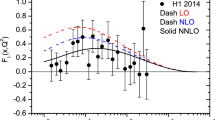Abstract
The d + d, t + p and h + n relative wavefunctions and their asymptotic normalizations are considered in the framework of the generator coordinate method (GCM) and compared with ATMS (amalgamation of two-body correlation into multiple scattering processes) method which used the realistic Reid soft core interaction. The asymptotic normalization of relative wavefunctions provide various coupling constants, the cluster probability amplitude (the so-called Z 1/2-factor) and matter RMS radii. These wavefunctions are also used to obtain 4He − d − d, 4He − t − p and 4He − h − n vertex functions in the virtual decay of 4He. The extrapolation of vertex functions for negative values of q 2 upto the corresponding poles provide the vertex constants which are comparable with other estimates. It is noticed that in GCM the coupling constants C 2 for 4He − d − d vertex is less than 2 as has been obtained in the forward dispersion relation technique.
Similar content being viewed by others
References
R Blankenbecler, M L Goldberger and F R Halpern, Nucl. Phys. 12, 629 (1959)
L S Shapiro, Theory of direct nuclear reactions (Moscow, Atomizdat, 1963)
Y E Kim and A Tubis, Annu. Rev. Nucl. Sci. 24, 69 (1974)
M P Locher and T Mizutani, Phys. Rep. C46, 43 (1978)
Y Akaishi, Cluster model and other topics (Singapore, World Scientific, 1986) p. 261
D R Tilley, H R Weller and G M Hale, Nucl. Phys. A541, 1 (1992)
S Fiarman and W E Meyerhof, Nucl. Phys. A206, 1 (1973)
P Heiss, B Bauer, H Aulenkampad and H Stowe, Nucl. Phys. A286, 42 (1977)
H M Hofmann, W Zahn and H Stowe, Nucl. Phys. A357, 139 (1981)
H Kanada, T Kaneko and Y C Tang, Phys. Rev. C34, 22 (1986)
D M Brink, In Proc. of the Int. School of physics, ‘Enrico Fermi’ Course 36, edited by C Bloch, p. 247 (New York, Academic, 1966)
H Horiuchi, Prog. Theor. Phys. (suppl.) 62, 1 (1977)
V K Sharma, in Developments of nuclear cluster dynamics (Singapore, World Scientific, 1989) p. 50
B K Chikara, Ph.D. Thesis, University of Meerut (1993)
H Morita, Y Akaishi and H Tanaka, Prog. Theor. Phys. 79, 863 (1988)
M Sakai, I Shimodaya, Y Akaishi, J Hiura and M Tanaka, Prog. Theor. Phys. (Suppl.) 56, 32 (1974)
L P Kok and A S Rinat, Nucl. Phys. A156, 593 (1970)
A S Rinat, L P Kok and M Stingl, Nucl. Phys. A190, 328 (1972)
L J B Goldfarb, J A Gonzalez and A C Phillips, Nucl. Phys. A209, 77 (1973)
L J B Goldfarb and E Parry, Nucl. Phys. A116, 289 (1968)
A N Mitra and V K Sharma, in Few body dynamics edited by A N Mitra, L Slaus, V S Bhasin and V K Gupta (Amsterdam: North-Holland, 1976)
V K Sharma, Pramana — J. Phys. 51, 733 (1998)
V S Bhasin and A N Mitra, Phys. Rev. Letts. 40, 1130 (1978)
A N Mitra, Nucl. Phys. 32, 529 (1962)
A N Mitra, in Advances in nuclear physics edited by M Baranger and E Vogt, vol. 3
D F Hebbard and B A Robson, Nucl. Phys. 42, 563 (1963)
M Abramowitz and I A Stegun, Handbook of mathematical function (New York, Dover, 1965)
A B Volkov, Nucl. Phys. 74, 33 (1964)
G Bertsch, J Borysowicz, H McManus and W G Love, Nucl. Phys. A284, 399 (1977)
In [16] (see eq. (3)) the vertex function is given with negative sign. Here we consider the positive sign as it will not affect the estimates of G 2 reported in table 1 and also consistent with the prescription given by Mitra and Sharma [18], to be discussed in §3.1.
S Dubnicka and O V Dumbrajs, Phys. Lett. B57, 321 (1975)
A G Baryshnikov, L D Blokhinstev and I M Narodetsky, Nucl. Phys. A272, 327 (1976)
M P Bornand, G R Plattnev, R D Viollier and K Alder, Nucl. Phys. A294, 492 (1978)
T K Lim, Phys. Rev. C14, 1243 (1976)
A G Baryshnikov, L D Blokhinstev, A N Safronov and V V Turovtsev, Nucl. Phys. A224, 61 (1974)
G R Plattner, R D Viollier, D Trautmann and K Alders, Nucl. Phys. A206, 513 (1973)
R Shyam, R G Lovas, K F Pal, V K Sharma and M A Nagarajan, J. Phys. G: Nucl. Phys. 11, 1199 (1985)
N M Clarke, J. Phys. G: Nucl. Phys. and Part. Phys. 18, 917 (1992)
Author information
Authors and Affiliations
Rights and permissions
About this article
Cite this article
Sharma, V., Chikara, B. Relative wavefunctions, vertex functions and coupling constants for the virtual decay of 4He. Pramana - J Phys 53, 707–725 (1999). https://doi.org/10.1007/s12043-999-0106-8
Received:
Revised:
Issue Date:
DOI: https://doi.org/10.1007/s12043-999-0106-8




